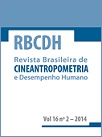Relationship between origin of shot and occurrence of goals in competitive men’s water polo matches
DOI:
https://doi.org/10.1590/1980-0037.2014v16n2p136Abstract
Although some similar studies exist in water polo, there are no reports show-ing a possible association between the occurrence of goals and the origin of shots. The objective of this study was to correlate the origin of shot and the occurrence of goals in an official men’s water polo match. Nine teams that competed in seven final matches of the Third National Men’s Water Polo League were evaluated. The games were recorded using a camera installed along the length of the pool. Pearson’s chi-square test was used to correlate the categorical variables studied. The effect size was calculated by the ratio between the chance of occurrence of a center goal and the chance of occurrence of a goal scored from the lateral position. An a value < 0.05 was adopted in all cases. There was a significant association between the occurrence of goals andorigin of shot, with X2(2) = 14.89 and p = 0.001, i.e., the proportion of goals scored from the center position was higher than that of goals scored from the lateral position. A center shot was 2.70 times more likely to be converted to a goal by the attacker. It can be concluded that a center shot presented a higher chance to be converted to a goal. This finding might be explained by the inability of the technical-tactical defense to organize, permitting closer proximity of the attack-ers. The same situation does not seem to apply to high-level technical-tactical matches.



